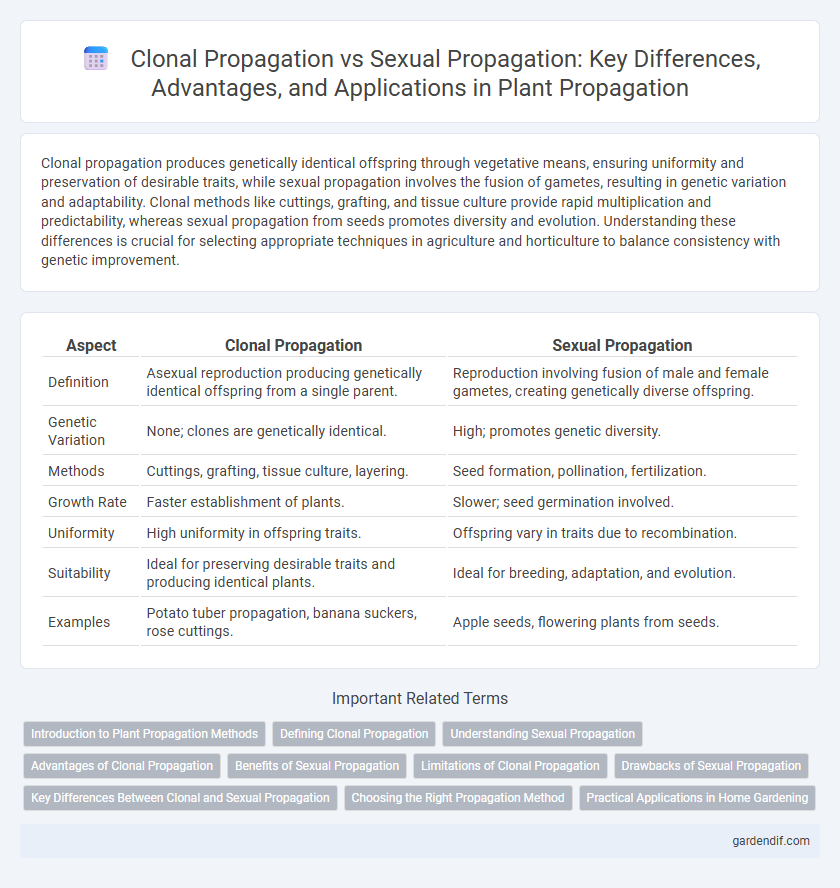
Clonal Propagation vs Sexual Propagation Illustration
Clonal propagation produces genetically identical offspring through vegetative means, ensuring uniformity and preservation of desirable traits, while sexual propagation involves the fusion of gametes, resulting in genetic variation and adaptability. Clonal methods like cuttings, grafting, and tissue culture provide rapid multiplication and predictability, whereas sexual propagation from seeds promotes diversity and evolution. Understanding these differences is crucial for selecting appropriate techniques in agriculture and horticulture to balance consistency with genetic improvement.
Table of Comparison
| Aspect | Clonal Propagation | Sexual Propagation |
|---|---|---|
| Definition | Asexual reproduction producing genetically identical offspring from a single parent. | Reproduction involving fusion of male and female gametes, creating genetically diverse offspring. |
| Genetic Variation | None; clones are genetically identical. | High; promotes genetic diversity. |
| Methods | Cuttings, grafting, tissue culture, layering. | Seed formation, pollination, fertilization. |
| Growth Rate | Faster establishment of plants. | Slower; seed germination involved. |
| Uniformity | High uniformity in offspring traits. | Offspring vary in traits due to recombination. |
| Suitability | Ideal for preserving desirable traits and producing identical plants. | Ideal for breeding, adaptation, and evolution. |
| Examples | Potato tuber propagation, banana suckers, rose cuttings. | Apple seeds, flowering plants from seeds. |
Introduction to Plant Propagation Methods
Clonal propagation involves reproducing plants asexually through methods like cuttings, grafting, and tissue culture, ensuring offspring are genetically identical to the parent plant. Sexual propagation relies on seeds formed through the fertilization process, promoting genetic diversity and adaptation to environmental changes. Both methods are essential in horticulture and agriculture for maintaining plant species and improving crop yields.
Defining Clonal Propagation
Clonal propagation is a method of plant reproduction that produces genetically identical offspring from a single parent plant through asexual means such as cuttings, grafting, or tissue culture. This technique ensures uniformity in plant traits, preserving desirable characteristics without the genetic variation found in sexual propagation. Clonal propagation is widely used in agriculture and horticulture to maintain consistency and enhance crop quality.
Understanding Sexual Propagation
Sexual propagation involves the combination of genetic material from two parent plants, resulting in offspring with genetic variation that enhances adaptability and resilience. This method relies on seed production through fertilization, promoting diversity essential for crop improvement and natural selection. Understanding sexual propagation is crucial for breeders seeking to introduce desirable traits and improve plant populations over generations.
Advantages of Clonal Propagation
Clonal propagation ensures uniformity and genetic consistency, producing offspring identical to the parent plant, which is crucial for maintaining desirable traits. This method accelerates plant production, enabling faster crop establishment and higher yield predictability compared to sexual propagation. It also bypasses the genetic variation and unpredictability inherent in seed-based reproduction, making it ideal for commercial horticulture and agriculture.
Benefits of Sexual Propagation
Sexual propagation enhances genetic diversity, which increases plant adaptability and resilience to environmental stressors and diseases. Seeds produced through sexual propagation allow for the development of unique traits, enabling breeders to select for improved crop yield, quality, and resistance. This method supports natural variation, facilitating evolutionary processes that sustain long-term agricultural sustainability.
Limitations of Clonal Propagation
Clonal propagation faces limitations such as reduced genetic diversity, which increases susceptibility to diseases and environmental changes. It also requires specific conditions and expertise to maintain the clones, making large-scale propagation costly and labor-intensive. Additionally, accumulated mutations over successive generations can lead to reduced vigor and yield in cloned plants.
Drawbacks of Sexual Propagation
Sexual propagation often results in genetic variability, which can lead to unpredictable plant traits and reduced uniformity in crops. Seeds produced through sexual reproduction might exhibit lower germination rates and increased susceptibility to diseases compared to clonally propagated plants. This variability can complicate large-scale agricultural production and breeding programs that require consistent plant quality.
Key Differences Between Clonal and Sexual Propagation
Clonal propagation produces genetically identical offspring through vegetative parts such as stems, roots, or leaves, ensuring uniformity and preservation of desirable traits. Sexual propagation involves the fusion of male and female gametes, resulting in genetically diverse offspring with varied traits due to recombination. Clonal propagation offers faster multiplication and consistent quality, while sexual propagation promotes genetic variation and adaptability to environmental changes.
Choosing the Right Propagation Method
Clonal propagation ensures genetic uniformity and faster multiplication of plants, ideal for preserving desirable traits in crops like bananas and apples. Sexual propagation promotes genetic diversity, enhancing adaptability and disease resistance in species such as tomatoes and sunflowers. Selecting the right propagation method depends on factors like crop type, production goals, and environmental conditions.
Practical Applications in Home Gardening
Clonal propagation enables home gardeners to reproduce desirable plant varieties with consistent traits by using cuttings, grafting, or layering, ensuring uniformity and faster maturation compared to sexual propagation. Sexual propagation, through seeds, introduces genetic diversity, which is beneficial for adapting plants to varying home garden environments and developing disease resistance. Combining both methods allows gardeners to maintain specific plant characteristics while also experimenting with new traits for improved home garden resilience and productivity.
Clonal Propagation vs Sexual Propagation Infographic

 gardendif.com
gardendif.com